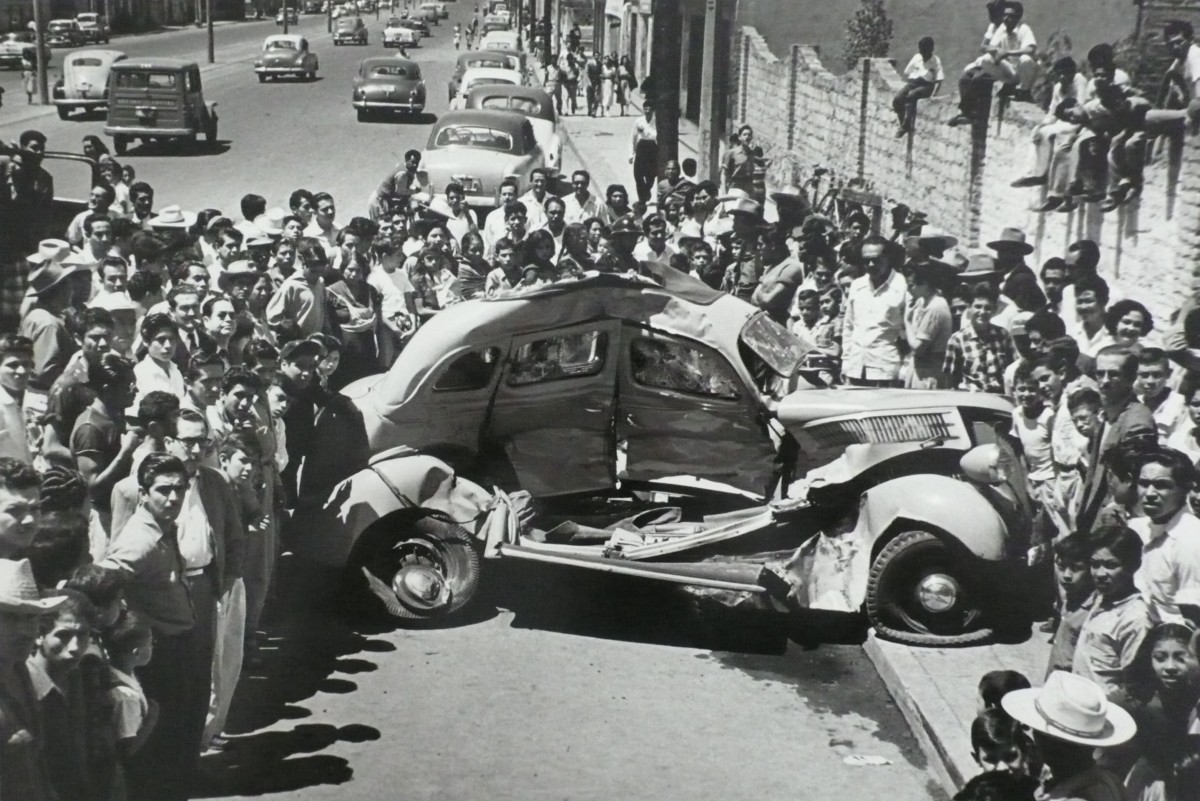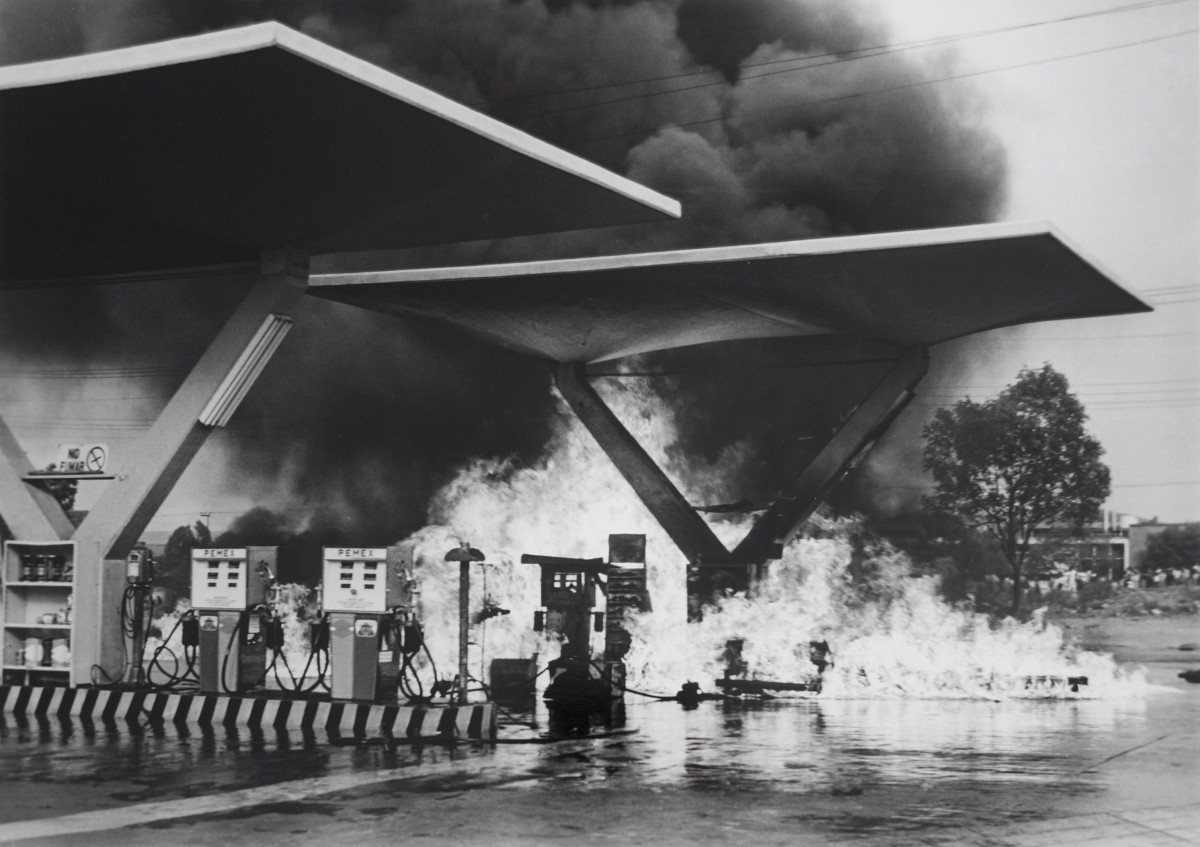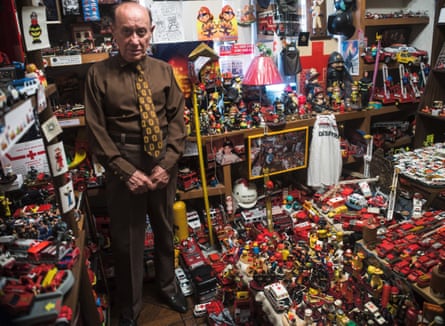
Untitled, Empleado de Telefonos de Mexico electrocutado en el km, 13 de la carretera Mexico-Toluca (Untitled, An Employee of Telefonos de Mexico Electrocuted at the 13-km mark on the Mexico-Toluca Highway), 1971, silver gelatin print, 20 x 24". https://www.artforum.com/picks/enrique-metinides-12175

https://www.michaelhoppengallery.com/exhibitions/150/overview/

https://www.michaelhoppengallery.com/exhibitions/150/overview/#/artworks_standalone/10480

https://www.michaelhoppengallery.com/exhibitions/150/overview/#/artworks_standalone/9865
Enrique Metinides was the greatest photographer of car crashes, crime scenes and disasters for Mexico’s sensational nota roja newspapers. He describes his life in the company of death, and why he collects emergency service toys
Barry Yourgrau
Looking casually dapper in a grey zip cardigan, Enrique Metinides leads me up to his modest apartment in Mexico City. Now in his 80s, the frail but chatty former photojournalist, celebrated for his images of crime and catastrophe, is often called the Weegee of Mexico, after his American counterpart, who gained notoriety for training his lens on the tragic scenes encountered by New York’s police, fire and ambulance services.
I had been a fan since 2003, when I first saw Metinides’ work in a group show in New York. The images disturbed and electrified me, in particular one of a dead woman who had been struck by a car, sprawled askew with an almost glamorous languor. Metinides was, as film-maker Trisha Ziff titled her 2016 documentary, The Man Who Saw Too Much.
These days, this chronicler of murderers, victims, suicides, drownings, car, train and plane wrecks, fires, morgues and earthquakes, stays at home with a collection of emergency vehicles and first responders, albeit in toy form. He has photographed them, restaging the kinds of scenes he shot while working. It seems an extraordinary twist, and of particular interest to me, as I have written a book about collecting, clutter and hoarding.

Metinides has an awful lot of these toys, apparently. None, though, reside in his living room. Instead, festive facemasks cover one wall. Pictures of the photographer and his three generations of offspring pack the mantel. Kitschy comical figurines cosy everywhere. And what is this? A vertical display case swarming with cartoonish green frogs? “For luck,” explains my host. “I always carried a frog – and a Virgin de Guadalupe – when I went to work.”
Jaralambos Enrique Metinides Tsironides was born in Mexico City in 1934 to Greek parents stranded in the country by the first world war. (Jaralambos, I later learn, invokes the name of a horribly tortured early Christian martyr.) His father had a camera shop, near where the collapsed hotel in Metinides’ striking 1985 earthquake shot stood. When Metinides was 10, his father gave him a box Brownie camera. He points to it now – on display with a hodgepodge of mementos, accompanied by a joke Brownie held in big Mickey Mouse hands.
The very young Metinides was mad about Hollywood gangster films. “I snuck off to movies all the time,” he says. “So I began taking photos of car accidents outside our house, in the style of those films.” One of the tall stacks of DVDs on his living-room floor shows the snarling faces of Jimmy Cagney in The Roaring Twenties and Edward G Robinson in Little Caesar: the sources of Metinides’ celebrated “cinematic” style.
His father subsequently opened a Greek restaurant frequented by cops and officials, who helped the schoolboy and his Brownie get special access, even to the morgue where, at the age of 11, little Enrique snapped his first corpse (well, more a severed head). One day, a press photographer saw him at the site of a car crash and took him under his wing – launching his career as prodigy of the nota roja, or red pages, the uniquely Mexican newspaper and magazine genre, heavy on violence, calamity and shock visuals, in which Metinides would star for a half-century.

Prodigy … at the age of 12 Metinides was already a seasoned street photographer and apprentice to “El Indio”, Antonio Velázquez. Photograph: Enrique Metinides/212Berlin films
The boy tagged along before school to sites of crime and calamity, including hellish Lecumberri, the city’s main prison. Firemen hefted him up on to their shoulders for his shots. He got his lifelong nickname: El Niño, The Kid. He was still just 11 when he began photographing murderers. His photos sometimes made the front pages. By 14, he had a contract. “The French have called me the youngest photographer in the world,” he exclaims proudly.
Hefting one of the books chronicling his work and times, he shows me his chubby pubescent self, standing with his mentor, Antonio “El Indio” Velázquez of La Prensa, the publication Metinides would be most associated with over his long career. It is a career that ended in 1997, but he has since found success in the international art world, with fervidly received exhibitions in New York, Paris, and London, handsomely annotated books, and a documentary film.
Back at the beginning, being so young, wasn’t he scared? “No, no,” comes the answer. “I was used to bodies and violence from the gangster films! What I tried to do in my career was make nota roja with art.” He shows me a photo of youngsters clutching together in horror as they gape beyond the picture frame. “A murder suicide – but I focused on the children, not the dead parents. The human drama. The new orphans.”
His photo of a woman who hanged herself in Chapultepec Park records her body alongside the towering, almost gothic boughs of the tree, so the picture tolls with the humblest, bleak abjection of her act. “And this kind of picture made me famous in Europe,” he says, displaying a derailed train locomotive keeled over at an impossible angle, dwarfing its onlookers.

Sex and raunchiness, I notice, are absent from his work. I ask what he thinks of today’s nota roja. With great contempt, he brandishes two current newspaper examples: Pasala and Metro. “Now they show a picture of the dead – and a naked person!” A blood-splashed thug with his throat cut shares a front page with a beautiful, near nude woman at the beach.
Nota roja – the phrase derives from the mark the Mexican inquisition put on orders for torture and death – arose in the latter part of the 19th century, chronicling bloody doings with illustrated texts. By the 1920s and 30s, technical advances had made press photography mainstream. Metinides represented the shifting emphasis, from the 1960s, to photos and briefer texts: the photojournalist’s hegemony. Then, in recent decades, Mexico’s narco-violence exploded – blowing out nota roja’s former aesthetics with off-the-scale savagery and non-stop atrocities. Talking of decapitated bodies in Acapulco, one leading editor declared in 2008: “That kind of piece really works for us.”
A new low would be plumbed on Valentine’s Day right after my visit to Metinides, when photos were published of a young woman who had been murdered, dismembered and skinned by her husband. One headline sniggered: “Cupid made him do it.”
Metinides casts aside Pasala and Metro and shakes his head in dismay. “So can we see your juguetes?” I chirp. “Your toys?” His face lights up. “Come on!” he cries. “But cuidado, watch out!”

Madcap mashups … one of Metinides’ Juguetes series – glossy photos of toy crime- and accident-scene recreations. Photograph: Enrique Metinides/212Berlin films
An entire toy stockroom seems to have been meticulously shoehorned into a broom cupboard. Edging in, I am terrified of knocking things over. Little red and yellow fire engines, ambulances and police cars pack the shelves, with tiny firemen, nurses, criminals and bobblehead cops crowded among them. A neat hodgepodging of emergency service memorabilia and ephemera envelop the walls: here a 9/11 cartoon of Superman asking a New York fireman for his autograph, there a firefighters’ banner sent as a gift from Lisbon. Jumbled in with it all are Metinides’ professional citations – and some of his nota roja photos.
“I have about 3,000 toys, collected over 40 years,” he says proudly. “That’s El Chapo Guzmán. I just bought him in Cuernavaca.” Alongside the mini Mexican warlord, armed with a couple of tiny AK-47s, is a red-nosed clown/fireman. Below this are bullet casings that Metinides collected at crime scenes. On a facing shelf, there’s a bright fire engine steered by a jolly Donald Duck. Beside it, there’s a Metinides photo of an inferno.
It’s as if his long and often harrowing career has been softened inside a niño’s playroom. One image stays with me, as it seems to perfectly sum things up: Metinides, surrounded by his toys, holds up an old black-and-white photo taken by his mentor, “El Indio”. It shows a demonic man in prison stripes leering with a knife.
“José Ortiz Muñoz, El Sapo, the Toad,” Metinides announces. “He killed over 100 people, then in jail he killed more people. I knew him at Lecumberri prison when I was young.” Right behind him and the Toad, I spot a big winsome caricature of Cantinflas, the beloved Mexican comedian, in his great 1952 film role, as Agente 777 in El Bombero Atómico, The Atomic Fireman. Metinides is a huge Cantinflas fan, it turns out, and a serious comedy lover. His favourites? Laurel and Hardy.

Law and disorder: the grisly lens of Enrique Metinides – in pictures
Back in the living room, he merrily pulls out some of his toy crime-scene recreations: large, gaudy, glossy photos, which he titles Juguetes. He made them a few years ago “when I was bored one afternoon”. For a lark, he posed some of his toys against the backdrop of his news works. A mini-cop Cantinflas salutes real cops dragging away a young guy at a protest. Goofy toy nurses stand against a background of a smashed VW and the bus that ploughed into it. A toy fireman is tangled in a hose in front of actual firemen silhouetted against a roaring blaze.
These madcap mashups – processed and printed at Costco – are, for some critics, unworthy of the great photographer’s oeuvre. But for me, they express his true self, showing that this chronicler of trauma and tragedy has an impish, even edgy comic streak.
After we say goodbye, I reflect on something Metinides casually confessed after listing all the injuries and ailments he acquired, thanks to “risking my life to track down pictures”. After showing me photos of himself scrambling from flames, hopping across roofs and rushing with an injured child in his arms (he took Red Cross training to ride in ambulances), he admitted that he was scared of flying. He has never attended any of his exhibitions in Europe or the US.
“Because when I was eight,” he explained, “some kids hung me off a building roof for five whole minutes. I was sick with fear from it.”
It’s an image, surely, his own camera would have feasted on.
• Barry Yourgrau is the author of Mess: One Man’s Struggle to Clean Up His House and His Act; his books of surreal short fiction include Wearing Dad’s Head and Haunted Traveller. He lives in New York.
• The Juguetes Portfolio and 101 Tragedies of Enrique Metinides are published by Aperture.









